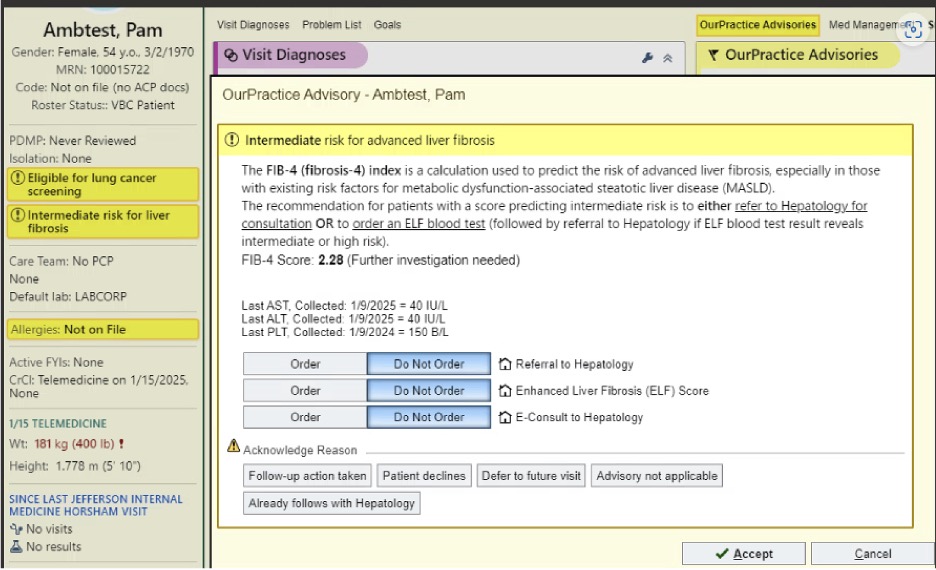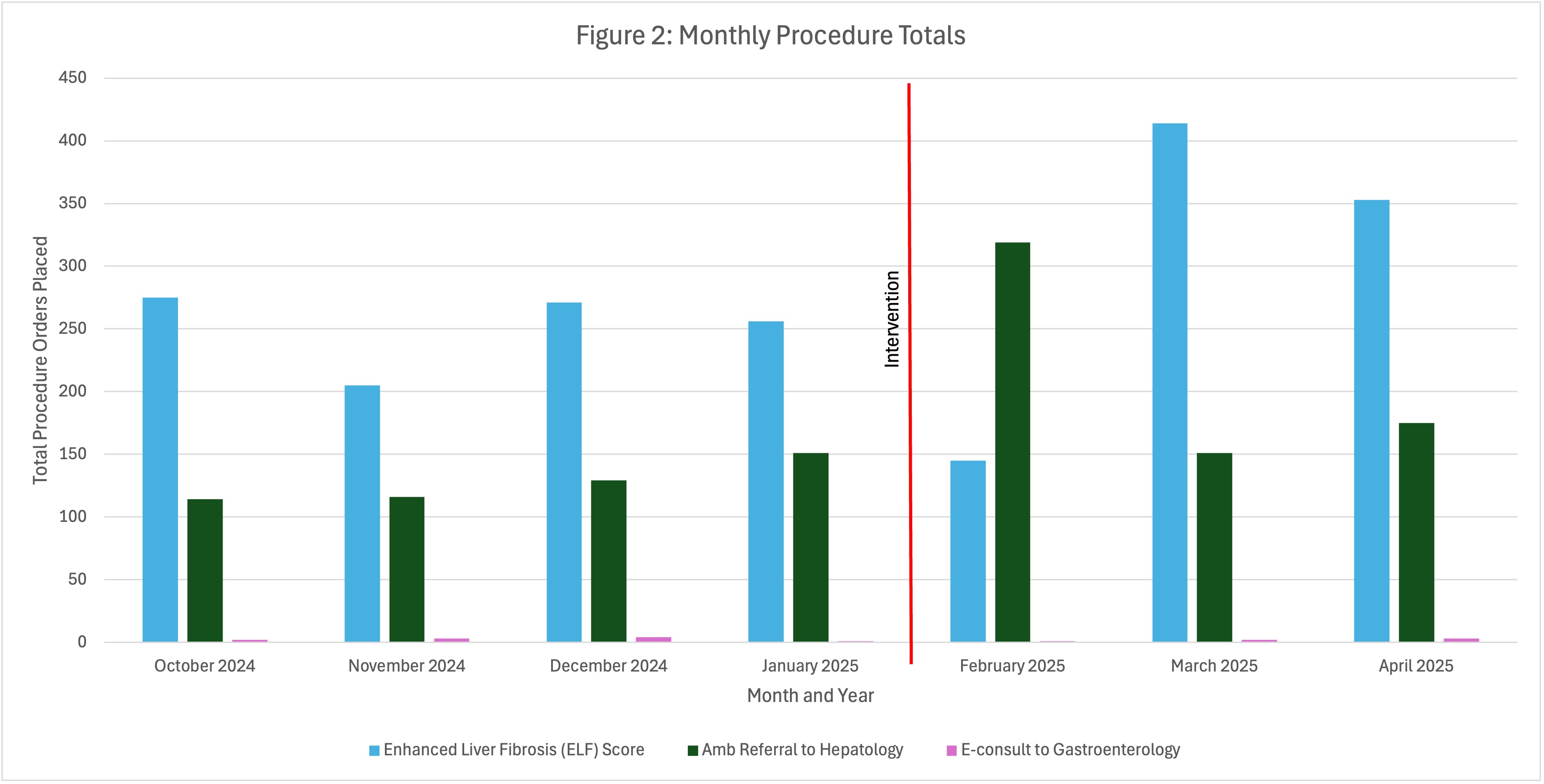Tuesday Poster Session
Category: Liver
P5862 - Use of EMR Automated FIB-4 as a Tool for MASLD Screening in the Primary Care Setting
Tuesday, October 28, 2025
10:30 AM - 4:00 PM PDT
Location: Exhibit Hall
- MW
Maria Winte, MD (she/her/hers)
Thomas Jefferson University Hospital
Philadelphia, PA
Presenting Author(s)
Maria Winte, MD1, Rebecca Loh, MD1, Sanjna Shelukar, MD1, Ananya Venkatesh, MD2, Bryan D.. O'Connell, MD3, Dina Halegoua-DeMarzio, MD1
1Thomas Jefferson University Hospital, Philadelphia, PA; 2Sidney Kimmel Medical College at Thomas Jefferson University, Philadelphia, PA; 3Thomas Jefferson Health, Jenkintown, PA
Introduction: The prevalence of Metabolic Dysfunction-Associated Steatotic Liver Disease (MASLD) has been increasing and is estimated to affect up to 40% of the population in North America. Screening for advanced fibrosis is now widely recommended, including formal guidelines from the AGA, AASLD, and ADA. We implemented an automated Fibrosis-4 (FIB-4) Index for liver fibrosis screening as a tool within our EMR to increase screening in patients with risk factors for MASLD. This study analyzes how our intervention affected appropriate MASLD screening rates among 50–65-year-old patients in the primary care clinic.
Methods: We launched an OurPractice Advisory (OPA) in Epic electronic medical record (EMR) (Figure 1) in 5 primary care clinics located in Philadelphia, PA in February 2025. FIB4 was automatically calculated for patients between the ages of 50-65 with metabolic risk factors, which included type 2 diabetes, hyperlipidemia, and/or obesity (BMI > 30). If FIB4 >1.3 to < 2.67, OPA recommended either an ELF (Enhanced Liver Fibrosis) blood test, ambulatory referral to hepatology, or an e-consult to gastroenterology. If Fib4 >2.67, ambulatory referral to hepatology was recommended. Pilot data was collected from February 2025- May 2025. Patients with previous elastography or ELF (enhanced liver fibrosis) test with last 1 year were excluded.
Results: Our OPA created a notable increase in generated ELF tests ordered and hepatology referrals per month. Following our intervention, 52 more ELF tests and 88 more referrals to hepatology were ordered on average per month compared to the preceding 4 months. There was still little utilization of e-consult to gastroenterology. E-consult orders ranged from 1-4 per month throughout the study.
Discussion: This pilot shows that creating an OPA within EMR is an effective way to increase screening for high-risk MASLD patients. The incorporation of ELF allows for further noninvasive risk stratification by primary care before hepatology referral. Further use and expansion of this tool could allow for MASLD screening of high-risk patients within large health systems.

Figure: Figure 1

Figure: Figure 2
Disclosures:
Maria Winte indicated no relevant financial relationships.
Rebecca Loh indicated no relevant financial relationships.
Sanjna Shelukar indicated no relevant financial relationships.
Ananya Venkatesh indicated no relevant financial relationships.
Bryan O'Connell indicated no relevant financial relationships.
Dina Halegoua-DeMarzio: 89BIO – Grant/Research Support. Akero – Grant/Research Support. Galectin – Grant/Research Support. Madigral – Advisory Committee/Board Member, Grant/Research Support, Speakers Bureau. Novo Nordisk – Grant/Research Support. Vertex – Advisor or Review Panel Member.
Maria Winte, MD1, Rebecca Loh, MD1, Sanjna Shelukar, MD1, Ananya Venkatesh, MD2, Bryan D.. O'Connell, MD3, Dina Halegoua-DeMarzio, MD1. P5862 - Use of EMR Automated FIB-4 as a Tool for MASLD Screening in the Primary Care Setting, ACG 2025 Annual Scientific Meeting Abstracts. Phoenix, AZ: American College of Gastroenterology.
1Thomas Jefferson University Hospital, Philadelphia, PA; 2Sidney Kimmel Medical College at Thomas Jefferson University, Philadelphia, PA; 3Thomas Jefferson Health, Jenkintown, PA
Introduction: The prevalence of Metabolic Dysfunction-Associated Steatotic Liver Disease (MASLD) has been increasing and is estimated to affect up to 40% of the population in North America. Screening for advanced fibrosis is now widely recommended, including formal guidelines from the AGA, AASLD, and ADA. We implemented an automated Fibrosis-4 (FIB-4) Index for liver fibrosis screening as a tool within our EMR to increase screening in patients with risk factors for MASLD. This study analyzes how our intervention affected appropriate MASLD screening rates among 50–65-year-old patients in the primary care clinic.
Methods: We launched an OurPractice Advisory (OPA) in Epic electronic medical record (EMR) (Figure 1) in 5 primary care clinics located in Philadelphia, PA in February 2025. FIB4 was automatically calculated for patients between the ages of 50-65 with metabolic risk factors, which included type 2 diabetes, hyperlipidemia, and/or obesity (BMI > 30). If FIB4 >1.3 to < 2.67, OPA recommended either an ELF (Enhanced Liver Fibrosis) blood test, ambulatory referral to hepatology, or an e-consult to gastroenterology. If Fib4 >2.67, ambulatory referral to hepatology was recommended. Pilot data was collected from February 2025- May 2025. Patients with previous elastography or ELF (enhanced liver fibrosis) test with last 1 year were excluded.
Results: Our OPA created a notable increase in generated ELF tests ordered and hepatology referrals per month. Following our intervention, 52 more ELF tests and 88 more referrals to hepatology were ordered on average per month compared to the preceding 4 months. There was still little utilization of e-consult to gastroenterology. E-consult orders ranged from 1-4 per month throughout the study.
Discussion: This pilot shows that creating an OPA within EMR is an effective way to increase screening for high-risk MASLD patients. The incorporation of ELF allows for further noninvasive risk stratification by primary care before hepatology referral. Further use and expansion of this tool could allow for MASLD screening of high-risk patients within large health systems.

Figure: Figure 1

Figure: Figure 2
Disclosures:
Maria Winte indicated no relevant financial relationships.
Rebecca Loh indicated no relevant financial relationships.
Sanjna Shelukar indicated no relevant financial relationships.
Ananya Venkatesh indicated no relevant financial relationships.
Bryan O'Connell indicated no relevant financial relationships.
Dina Halegoua-DeMarzio: 89BIO – Grant/Research Support. Akero – Grant/Research Support. Galectin – Grant/Research Support. Madigral – Advisory Committee/Board Member, Grant/Research Support, Speakers Bureau. Novo Nordisk – Grant/Research Support. Vertex – Advisor or Review Panel Member.
Maria Winte, MD1, Rebecca Loh, MD1, Sanjna Shelukar, MD1, Ananya Venkatesh, MD2, Bryan D.. O'Connell, MD3, Dina Halegoua-DeMarzio, MD1. P5862 - Use of EMR Automated FIB-4 as a Tool for MASLD Screening in the Primary Care Setting, ACG 2025 Annual Scientific Meeting Abstracts. Phoenix, AZ: American College of Gastroenterology.
